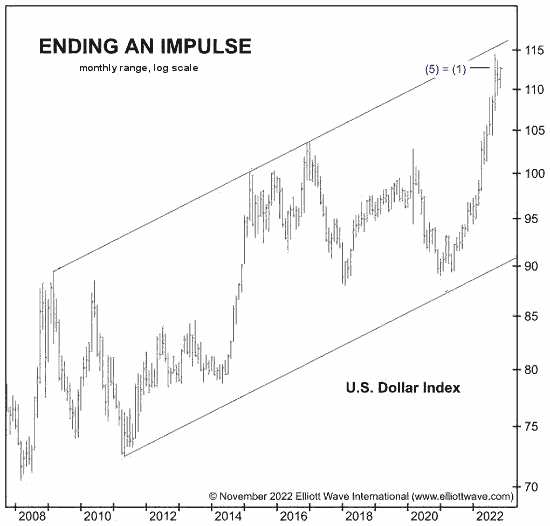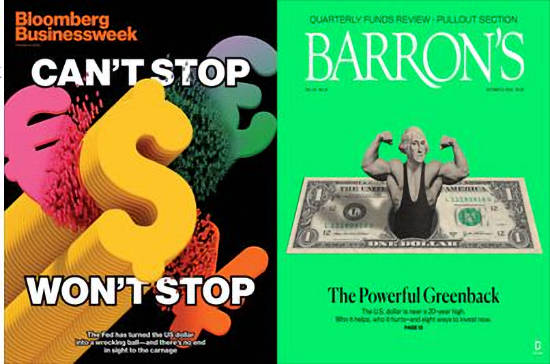The Greenback’s Elliott Waves are Showing the Way
By Elliott Wave International
Investors who use Elliott wave analysis know that the primary price trend of a financial market subdivides into five waves.
Also, know that wave 1 and wave 5 are often approximately equal in length.
That knowledge helped the Global Market Perspective, a monthly Elliott Wave International publication that covers 50-plus financial markets, make a successful call on the U.S. Dollar index.
The November issue showed a monthly chart that dates back more than 14 years and said:

The U.S. Dollar Index continues to look like it’s topping. The index is testing the level where wave (5) would equal wave (1), a common relationship.
Keep in mind that Global Market Perspective subscribers get to see all the wave labeling.
With the benefit of hindsight, we now know that the top registered on Sept. 28 — still, that doesn’t discount the fact that the topping process was recognized by using Elliott wave analysis.
Since that analysis on Nov. 4, the U.S. Dollar Index has declined in price.
Another giveaway that the greenback was headed for a tumble is that the mainstream seemed to be growing a bit too confident about the prospect for a further rise in the index. These two magazine covers provide examples of that:
The late analyst Paul Macrae Montgomery showed over the years that specialist industry magazines sometimes highlight financial trends on their covers just as those trends are ending.
Of course, Elliott wave analysis nor any indicator — such as the magazine cover indicator — can offer a guarantee about future market action, but the Elliott wave model and many time-tested indicators have proven to be quite useful throughout different market cycles.
If you’d like to learn about the Elliott wave model, know that the definitive text on the subject is Frost & Prechter’s Wall Street classic, Elliott Wave Principle: Key to Market Behavior. Here’s a quote from the book which should be in every serious investor’s library:
[R.N.] Elliott himself never speculated on why the market’s essential form is five waves to progress and three waves to regress. He simply noted that that was what was happening. Does the essential form have to be five waves and three waves? Think about it and you will realize that this is the minimum requirement for, and therefore the most efficient method of, achieving both fluctuation and progress in linear movement. One wave does not allow fluctuation. The fewest subdivisions to create fluctuation is three waves. Three waves (of unqualified size) in both directions would not allow progress. To progress in one direction despite periods of regress, movements in that direction must be at least five waves, simply to cover more ground than the intervening three waves. While there could be more waves than that, the most efficient form of punctuated progress is 5-3, and nature typically follows the most efficient path.
Good news: You can read the entire online version of the book for free once you become a member of Club EWI, the world’s largest Elliott wave educational community.
A Club EWI membership is also free and allows you complimentary access to a treasure trove of Elliott wave resources on financial markets, investing and trading. These resources include videos and articles from Elliott Wave International’s analysts.
Hop on the Club EWI bandwagon now by following this link: Elliott Wave Principle: Key to Market Behavior — get free and instant access.
This article was syndicated by Elliott Wave International and was originally published under the headline U.S. Dollar: Has the Mainstream Been Way Too Confident?. EWI is the world’s largest market forecasting firm. Its staff of full-time analysts led by Chartered Market Technician Robert Prechter provides 24-hour-a-day market analysis to institutional and private investors around the world.

Speak Your Mind